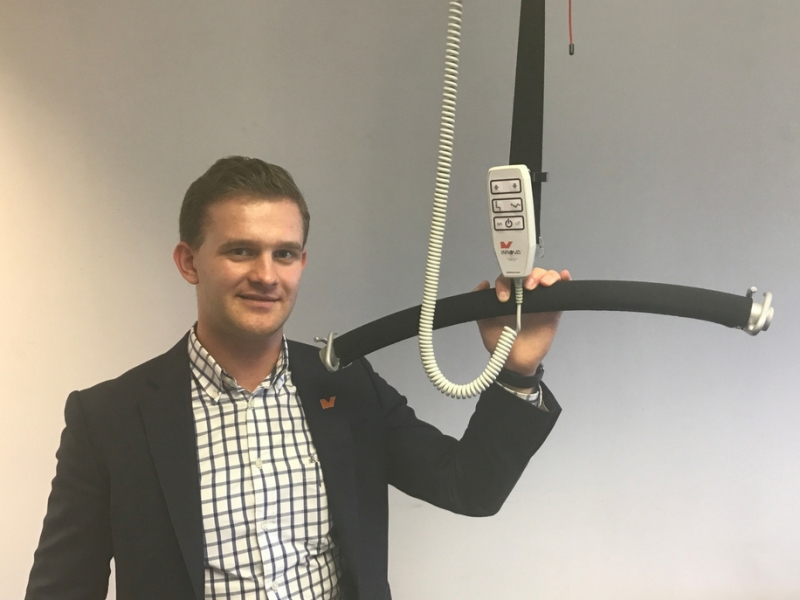A large number of hospital patients are elderly or have mobility problems.
Modern hoisting systems can assist with physiotherapy, rehabilitation, and care procedures such as dressing wounds, turning in bed, and supporting limbs
And, in an age of compensation culture; patient lifting and transfer has to be carried out with the utmost safety in order to avoid injury to either staff or the person being moved.
Modern hoist equipment is helping to address this, offering tried-and-tested solutions that, not only address the risk factors associated with lifting weight, but also, in some cases, enable people to self-lift, freeing up staff for other patient-facing duties and increasing independence.
Bob Oliver, hoisting specialist at Innova, said: “It is now recognised that hoists can be used for a much-broader range of activities than just in- and out-of-bed transfers.
“Modern hoisting systems can assist with physiotherapy, rehabilitation, and care procedures such as dressing wounds, turning in bed, and supporting limbs.”
Choose carefully
There are three main types of hoisting systems.
- Ceiling – these run permanently along fixed tracks so offer less flexibility than mobile systems, but they do not take up floor space like mobile units and can be operated independently by the user. They are generally more suitable for longer-distance transfers
- Portable overhead (gantry): These are useful for where a hoist is required in a particular place for a short amount of time. They fold into their own wheeled carrying cases, which can be stowed easily
- Mobile hoists: Being self-contained, these do not require any track installation, so offer more flexibility. They do, however, demand more of the carer and are not designed for moving people long distances. They also take up floor space as they use legs to support them
Within these systems are a further range of choices, all driven by current trends and demands.
For example, over the past couple of years more bariatric ranges have been launched to address the growing problem of obesity.
ArjoHuntleigh, for example, has launched The Tenor, a mobile solution that can carry up to 320kg – just over 50 stones.
In addition, self-operating systems give users more independence and charge-on-the-rail options mean less time is spent recharging batteries.
Quality and clarity
Oliver added: “The very-latest hoisting equipment can now easily navigate multi-user environments like hospitals, without standing out like a sore thumb.”
Innova recently won an £850,000 contract to fit 277 hoists across 313 rooms at the new Midland Metropolitan Hospital in Birmingham because of its unique curtain solution, which enables a hoist unit to be shared between beds and to pass over curtain rails.
Hoist systems will become easier to use and will be able to cater for more and more activities that are routinely being carried out by nursing and care staff
Emma Loosely, the hospital’s senior commissioning manager, said: “By sharing motor units between bed spaces, the trust is minimising the impact on patients within that space. It also means fewer motor units to maintain and test annually.”
The company also supplied products to the Hollybank Trust in Mirfield, West Yorkshire, a school for children with complex needs.
When specifying the right solution, Oliver advises: “It is vital to ensure the system is as flexible as possible and allows for changes in bedroom layouts and a variety of different client types.
“Wherever possible, make it discreet so as not to damage the homely appearance of a room or cause agitation for clients or patients.”
Robin Tuffley, marketing manager at Clos-o-Mat, added: “Whether new-build or refurbishment; the structure needs to be strong enough to support the weight loading if a ceiling track is being used.
“The key is proper and quality installation, good staff training, and a clear policy about usage.”
When selecting mobile hoists, particular attention needs to be paid to where the legs are going to go and whether the floor surface is smooth enough to allow easy operation. Thick carpet or threshold strips are difficult to manoeuvre over.

Bob Oliver with Innova's hoist handset, a next-generation system which is helping to reduce injuries
The future is bright
It is also important to check there is sufficient operating range to lift a person clear of any surface, and perhaps also to pick them up from floor level in an emergency.
And mobile systems need to be stored when not in use, preferably in an area where they are out of the way, and with a charging point for their battery; while ceiling systems may mean joists need to be reinforced and doorways altered.
The very-latest hoisting equipment can now easily navigate multi-user environments like hospitals, without standing out like a sore thumb
The popularity of hoist systems is only set to continue, as under BS8300:2009 it is recommended that all new-build multi-occupancy buildings, such as hospitals and care homes, provide a minimum 5% of bedrooms with a fixed-track hoist system and a further 5% offering capability for future adaptation.
“Research and development continues apace in this market, with some of the latest drivers leading to the launch of charge-on-the-rail and self-lifting equipment.
Tuffley said: “Developments coming on stream include more-discreet gantry leg systems and improvements in battery technology and faster charging.”
Oliver added: “Hoist systems will become easier to use and will be able to cater for more and more activities that are routinely being carried out by nursing and care staff.”




